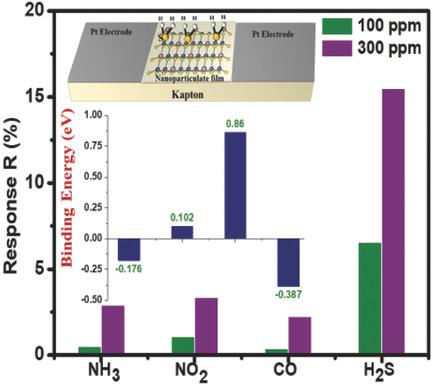当前位置:
X-MOL 学术
›
Adv. Mater. Interfaces
›
论文详情
Our official English website, www.x-mol.net, welcomes your feedback! (Note: you will need to create a separate account there.)
A Combined Experimental and Computational Study of Gas Sensing by Cu3SnS4 Nanoparticulate Film: High Selectivity, Stability, and Reversibility for Room Temperature H2S Sensing
Advanced Materials Interfaces ( IF 5.4 ) Pub Date : 2018-02-26 , DOI: 10.1002/admi.201701492 Thripuranthaka M 1 , Neha Sharma 2 , Tilak Das 1 , Swapnil Varhade 2 , Satish S. Badadhe 1 , Musthafa Ottakam Thotiyl 2 , Mukul Kabir 1 , Satishchandra Ogale 1
Advanced Materials Interfaces ( IF 5.4 ) Pub Date : 2018-02-26 , DOI: 10.1002/admi.201701492 Thripuranthaka M 1 , Neha Sharma 2 , Tilak Das 1 , Swapnil Varhade 2 , Satish S. Badadhe 1 , Musthafa Ottakam Thotiyl 2 , Mukul Kabir 1 , Satishchandra Ogale 1
Affiliation

|
Several binary sulfides are used for sensing of gases such as NH3, NO2, and H2, but not for H2S, especially at room temperature, because of the relative inactivity of metal sulfide surface bonds for this gas. The situation can be entirely different in the ternary case, however, due to the possible synergy of interactions involving dual cation surface chemistry. This is borne out by the present work wherein the Cu3SnS4 material, the Cu‐rich ternary sulfide used for the first time in the gas sensing context, not only senses H2S at room temperature but also remarkably does so with high selectivity and stability. Thus, a combined experimental and computer modeling study on the use of nanocrystalline orthorhombic Cu3SnS4 phase is reported for H2S sensing. The material shows sensitivity for a wide range of H2S concentrations (from 10 to 2000 ppm). The performance of the sensing device fabricated on Kapton substrate remains intact even after several days and multiple bending cycles. Importantly, these experimental findings are consistent with the results of density functional theory calculations for binding energies for different gases, namely, H2S, NO2, NH3, and CO, on Cu3SnS4 surface.
中文翻译:

Cu3SnS4纳米颗粒膜气体传感的组合实验与计算研究:室温H2S传感的高选择性,稳定性和可逆性
几种二元硫化物用于感测诸如NH 3,NO 2和H 2之类的气体,但不适用于H 2 S,特别是在室温下,这是因为金属硫化物表面键对于该气体的相对惰性。然而,由于涉及双阳离子表面化学的相互作用可能协同作用,在三元情况下情况可能完全不同。当前的工作证明了这一点,其中在气体检测环境中首次使用的Cu 3 SnS 4材料(富含铜的三元硫化物)不仅可检测H 2,S在室温下也具有很高的选择性和稳定性。因此,报道了使用纳米晶正交Cu 3 SnS 4相进行H 2 S感测的组合实验和计算机模型研究。该材料显示出对各种H 2 S浓度(10至2000 ppm)的敏感性。即使经过几天和多次弯曲循环,在Kapton基板上制造的传感设备的性能仍保持不变。重要的是,这些实验结果与密度函数理论计算的结果不同,该函数用于计算Cu上不同气体(H 2 S,NO 2,NH 3和CO)的结合能3 SnS 4表面。
更新日期:2018-02-26
中文翻译:

Cu3SnS4纳米颗粒膜气体传感的组合实验与计算研究:室温H2S传感的高选择性,稳定性和可逆性
几种二元硫化物用于感测诸如NH 3,NO 2和H 2之类的气体,但不适用于H 2 S,特别是在室温下,这是因为金属硫化物表面键对于该气体的相对惰性。然而,由于涉及双阳离子表面化学的相互作用可能协同作用,在三元情况下情况可能完全不同。当前的工作证明了这一点,其中在气体检测环境中首次使用的Cu 3 SnS 4材料(富含铜的三元硫化物)不仅可检测H 2,S在室温下也具有很高的选择性和稳定性。因此,报道了使用纳米晶正交Cu 3 SnS 4相进行H 2 S感测的组合实验和计算机模型研究。该材料显示出对各种H 2 S浓度(10至2000 ppm)的敏感性。即使经过几天和多次弯曲循环,在Kapton基板上制造的传感设备的性能仍保持不变。重要的是,这些实验结果与密度函数理论计算的结果不同,该函数用于计算Cu上不同气体(H 2 S,NO 2,NH 3和CO)的结合能3 SnS 4表面。


























 京公网安备 11010802027423号
京公网安备 11010802027423号